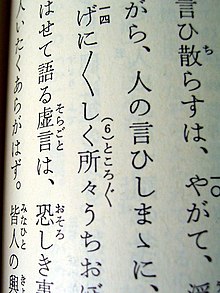Odoriji
Odoriji ( Japanese 踊 り 字 ) are used in Japanese to denote a repeated character. So z. B. hitobito (people) 人 々 written instead of 人人 .
Kanji
The Kanji repetition character 々 , originally a simplified form of 仝 , is used to indicate a repeated Kanji:
- 山 山 → 山 々 ( yamayama , dt. "Mountains")
- 時時 → 時 々 ( tokidoki , Eng . "Sometimes")
- 明明 白白 → 明 々 白 々 ( meimei hakuhaku , German "clarity")
- 赤裸裸 → 赤裸 々 ( sekirara , German "naked; blunt")
- 複 複 複線 → 複 々 々 線 ( fukufukufukusen , German "eight-track railway line", fuku means "double")
In compound words in which both the same Kanji originate from compound single words, the repetition character is not used, e.g. B. in the word 民主主義 ( minshu shugi , dt. “Democracy”), which consists of 民主 ( minshu , dt. “Popular sovereignty”) and 主義 ( shugi , dt. “Principle; -ism ”).
The repeat symbol can also be used on consecutive 2 kanji:
- 部分 部分 → 部分 々 々 ( bubunbubun , German "parts, sections")
- 後手 後手 → 後手 々 々 ( dotedote , German "always be too late")
The character is also called noma in Japanese because it looks like the katakana letters ノ ( no ) and マ ( ma ).
There is also the variant 〻 for use in vertical font; however, this has become very rare in modern texts.
Kana
There are two repeat signs for Kana -texts, ゝ for Hiragana and ヽ for Katakana . They are mainly used in proper names, e.g. B. in さ ゝ き ( Sasaki ), and can also be combined with voiced signs ( dakuten ) if the repeated syllable is voiced, e.g. B. in じ ゞ ( Jiji ) or い す ゞ ( Isuzu ).
Double height characters
There is also the double-height repeat symbol 〱 , which is used in vertical text, but is practically no longer used today. Since it is reminiscent of the hiragana character く Ku, it has the name く の 字 点 ( ku-no-jiten ).
If the voiced character is used to repeat an entire word, only the first syllable is voiced, e.g. B. in tokorodokoro :
| と こ ろ 〴 〵 |
In contrast to the ゝ , the repeat symbol does not have to be combined with the voiced symbol if the syllable to be repeated is already voiced.
